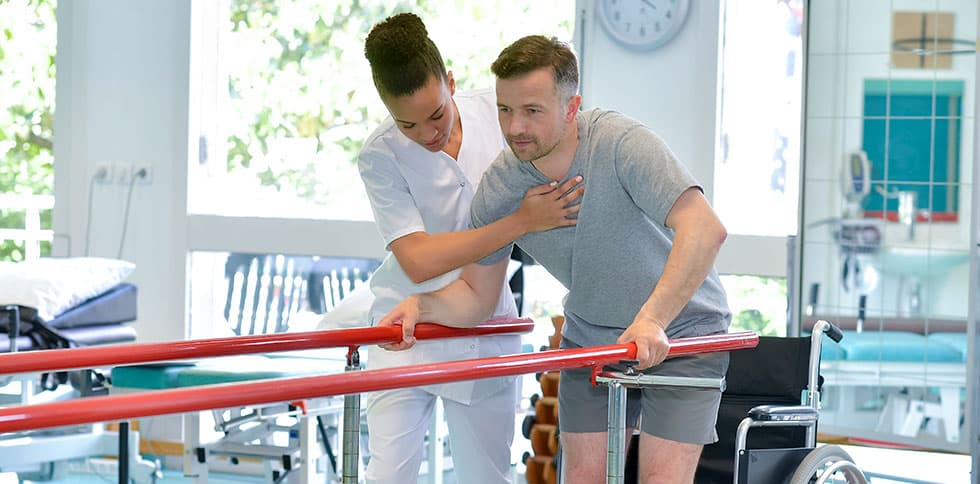A spinal cord injury can have a devastating effect on your ability to function physically and on your quality of life. Spinal cord injuries may cause anything from chronic pain to partial loss of mobility to widespread paralysis (tetraplegia) that leaves you bedridden.
To better support those affected by spinal cord injuries, we’ve created a Spine Injury Resource Center with in-depth information on living with spinal cord damage—something that impacts approximately 273,000 people in the U.S. The New York area is home to several top-rated spinal cord rehabilitation centers and community support groups, providing essential care and resources for patients and their families.
Spinal Cord Rehab
Spinal cord injuries (SCIs) vary in severity, but most patients go through distinct phases of recovery during rehabilitation. The length of each phase differs based on the individual and the extent of their injury.
SCIs are classified into two main types:
- Incomplete Spinal Cord Injury – Some brain signals still reach the extremities, allowing for partial movement and sensation.
- Complete Spinal Cord Injury – No sensation or movement exists below the injury site.
Treatment typically falls into two stages: acute care, which focuses on stabilizing the injury, and rehabilitation, which helps patients regain function and adapt to their condition.
Step One: Emergency Medical Care
Immediate emergency care is critical in a spinal cord injury (SCI) to prevent further damage and manage trauma. Emergency responders immobilize the spine using a neck collar and rigid backboard before transporting the patient to a hospital for assessment.
Emergency Response Process:
- Accident Occurs (Car crashes, falls, construction accidents, etc.)
- Emergency Services Arrive & Assess the Patient
- Spinal Immobilization to prevent further injury
- Emergency Life-Saving Techniques Applied
Step Two: Acute Stage Treatment
The acute phase of SCI treatment focuses on stabilizing the patient and preventing complications such as breathing issues, blood clots, and infections. Many patients remain heavily sedated to minimize movement and reduce further spinal damage.
Key Acute Care Steps:
-
Emergency Room Assessment – Patients with spinal cord injuries in New York City are often transported to Level 1 trauma centers like NYU Langone, New York-Presbyterian/Weill Cornell, or Mount Sinai for immediate evaluation. These hospitals have specialized teams equipped to assess spinal trauma severity.
-
Critical Care Administered – Emergency physicians and trauma specialists provide breathing support, IV medications to reduce inflammation, and stabilize vital functions to prevent further damage. NYC hospitals have state-of-the-art neurocritical care units designed for spinal cord injury patients.
-
Patient Transferred – Once stabilized, patients may be moved to the Mount Sinai Spinal Cord Injury Model System, NYU Langone’s Rusk Rehabilitation, or Kessler Institute for Rehabilitation in New Jersey, depending on the severity of the injury and long-term care needs.
-
Extensive Testing – Advanced imaging, including MRI and CT scans, is performed to evaluate spinal cord bruising, compression, or tearing. NYC hospitals use cutting-edge diagnostic tools to determine the best treatment plan.
Patients with neck-level spinal cord injuries often face severe respiratory challenges and require long-term ventilator support.
Step Three: Surgery
Some spinal cord injuries require surgical intervention to remove bone fragments, repair fractured vertebrae, or relieve pressure on the spinal cord. Research suggests that early surgery (within 24 hours) can improve patient outcomes.
Surgical Treatment Process:
- Surgical Removal of bone fragments or foreign objects pressing on the spine
- Fracture Repair to stabilize damaged vertebrae
- Anti-Inflammatory Medications to reduce swelling and aid healing
- Continuous Monitoring before, during, and after surgery to prevent complications
Step Four: Addressing Secondary Medical Problems (Ongoing)
SCI patients often face long-term health challenges, including muscle contractions, pressure ulcers, bladder and bowel dysfunction, infections, and blood clots. Proper management is essential to prevent life-threatening complications.
Ongoing Medical Care Includes:
- Monitoring Bowel & Bladder Function to prevent kidney damage
- Addressing Muscle Spasticity & Blood Clots
- Positioning & Skin Care to prevent pressure sores
- Pain Management & Depression Treatment through medication and counseling
Step Five: Rehabilitation
The process of rehabilitation provides the tools to help the spinal cord injury survivor deal with the most serious effects of spinal cord injury such as reduced bladder function, muscle spasticity and loss of sensation, and advance toward independence. Rehabilitation marks the transition from a focus on medical treatment to a focus on restoring function to handle daily activities. It starts once the patient has recovered to a degree that the process can be initiated.
As a general rule, a rehabilitation facility that has received accreditation from the Rehabilitation Accreditation Commission for spinal cord injury shows that the facility meets a certain standard of care.
The initial phase of rehabilitation involves regaining as much movement in the arms and legs as possible, depending on the location and severity of the injury. The paralyzed parts of the body often are spastic and the bowel and bladder become spastic as well. The pace of rehabilitation depends on the patient. The earlier it begins, the better for the patient, as movement of the limbs is essential to maintain cardiovascular health during recovery.
Various systems are employed to help spinal cord injury survivors regain a level of independent action. Some of the most common processes used in spinal cord rehabilitation centers include the Dardzinski Method, the processes developed by the National Institute of Neurological Disorders and Stroke Coordination Dynamics Therapy, and others. All of these processes follow a general pattern of treatment and rehabilitation. Newer technologies employed in treating spinal cord injuries allow patients to recover additional functions that were impossible in earlier years.
The team of professionals involved in the rehabilitation process may include a physical therapist, occupational therapist, rehab nurse and psychologist, social worker, dietician, recreation therapist, and physician who is a specialist in spinal cord injuries. The patient is educated on what to expect and the importance of maintaining existing muscle function and mobility.
Work will be undertaken for the patient to restore fine motor skills and learn adaptive techniques to assist in performing day-to-day tasks. This process generally takes several months to complete, and the patient will be busy learning new skills and training on how to operate in daily life with impairments.
- Patient Transferred to a top spinal cord rehab center, such as Mount Sinai Spinal Cord Injury Model System, NYU Langone’s Rusk Rehabilitation, or Kessler Institute for Rehabilitation
- Customized Rehab Plan Developed based on injury severity and personal recovery goals
- Physical & Occupational Therapy at facilities like Burke Rehabilitation Hospital or the Hospital for Special Surgery, focusing on restoring movement, coordination, and strength
- Medical Equipment Training for mobility aids, adaptive devices, and cutting-edge exoskeleton technology available at premier NYC rehab centers
- Family Education & Support programs to assist with long-term care, including resources from United Spinal Association (headquartered in NYC)
- Ongoing Monitoring by spinal cord injury specialists, ensuring continuous progress and adjustment of therapy plans
Step Six: Recovery
SCI recovery varies, but most functional improvements occur within the first six months. However, some patients continue to regain minor motor function for up to a year after injury.
Final Recovery Steps:
- Patient Assessed for their final level of recovery
- Last-Stage Training before transitioning home
Many patients recover more function than expected, as the spinal cord has redundant neural pathways that may compensate for damaged areas.
Step Seven: Home Care
Returning home after an SCI requires significant lifestyle adjustments, including home modifications for wheelchair accessibility. Ongoing care, training, and support groups can help patients and their families navigate daily life.
Home Transition Process:
- Home Modifications for accessibility (bathroom, doorways, ramps, etc.)
- Patient Transferred Home with continued support
- Training for Daily Tasks, including driving and personal care
- Regular Medical Checkups to monitor ongoing health
The costs of rehabilitation and ongoing care for spinal cord injury survivors make it imperative to understand your legal options if your injury was caused through the negligence of another party. The spinal cord injury attorneys at Hecht, Kleeger and Damashek can review your accident at no charge and explain your legal options.
Tell Us What Happened
"*" indicates required fields


